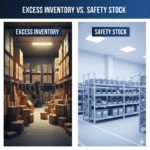Excess inventory can be a significant drain on a business’s resources. Storing unsold products leads to high storage costs, potential damage, and the risk of goods becoming obsolete. Studies show that businesses could be losing up to 30% of their inventory value annually due to storage, insurance, and depreciation costs. In 2025, more businesses are seeking solutions to liquidate their extra stock efficiently, recover their investment, and optimize their inventory management.
LiquidateProducts offers a streamlined process that can help businesses convert surplus stock into cash quickly, while also freeing up valuable warehouse space. By understanding the strategies for inventory liquidation, your business can save both time and money.
1. Assess Your Inventory: Identifying Surplus Stock
Before deciding on a liquidation method, the first step is to assess your excess inventory. Accurate assessment ensures that only surplus or obsolete products are sold. Key metrics like the inventory turnover ratio and days sales of inventory (DSI) can help identify slow-moving or unsellable stock.
Key Tips for Inventory Assessment:
- Inventory Turnover Ratio: This ratio helps you understand how quickly your products are selling and how much stock remains unsold.
- Days Sales of Inventory (DSI): This metric reveals how long it takes for a product to sell. If this number is too high, it may be time to liquidate those products.
By using advanced tools such as AI-driven inventory management systems, businesses can gain real-time insights into product performance. This enables more informed decision-making when it comes to liquidation.
2. Choose the Right Liquidation Method
Once you’ve identified excess inventory, the next step is to choose the right liquidation method. Below are the most common strategies:
- Bulk Sales to Liquidators:
Partnering with Bulk Inventory Buyers allows businesses to quickly convert excess stock into cash. Liquidators buy products in bulk, taking on the responsibility of selling them at a lower price, which is ideal for businesses that need to move large quantities quickly. Bulk sales offer the benefit of fast turnover, freeing up valuable warehouse space. - Online Marketplaces:
Websites such as Amazon, eBay, and Overstock provide platforms to sell surplus stock to a broader audience. While this method requires more effort in terms of managing listings, shipping, and customer service, it can help businesses reach more potential buyers. - Discount Retailers:
Selling your products to discount stores or outlets is a common approach to offloading surplus goods. This method works well for seasonal, off-brand, or excess inventory that is unlikely to sell at full price. - Donations:
In cases where products are unsellable, donating items to charities not only helps the community but may also provide tax benefits. It’s a way for businesses to improve their social responsibility image while clearing out unsellable stock.
3. Prepare Your Inventory for Sale
Once the liquidation method is decided, preparing your inventory for sale is essential to ensuring a smooth process. Here’s how to prepare your excess stock for liquidation:
- Organize Your Inventory:
Create a detailed manifest listing product descriptions, quantities, conditions, and any distinguishing features. This helps both you and potential buyers understand what’s on offer. - Proper Packaging:
To avoid product damage, ensure that your items are packaged securely before shipping. Proper packaging can help preserve the quality of your products during transportation. - Documentation:
Having proper documentation like invoices, receipts, and warranties (if applicable) will speed up the liquidation process and provide security for both parties.
4. Partner with Reliable Liquidators
When it comes to liquidating inventory, partnering with a reputable liquidator can make all the difference. Companies like LiquidateProducts provide a range of benefits:
- Fast Turnaround:
Businesses can receive a quote within 24 hours of submitting their inventory details, ensuring a quick and efficient process. - Upfront Payment:
One of the key advantages of working with a professional liquidator is that businesses often receive upfront payment before shipping the products. This helps with cash flow management. - Flexible Solutions:
Whether you need to offload a single pallet or an entire warehouse of goods, LiquidateProducts can tailor their services to your needs. This flexibility allows businesses of all sizes to liquidate their stock effectively. - Avoid Amazon FBA Fees:
For Amazon sellers, LiquidateProducts helps offload surplus inventory stored in FBA warehouses, saving sellers from expensive long-term storage fees.
5. Execute the Liquidation
After preparing your inventory and choosing a liquidation method, it’s time to execute the plan. Keep track of the entire process to ensure that payments are made promptly and issues are resolved swiftly.
Key Actions During Execution:
- Follow-Up:
Regularly check the progress of your liquidation efforts, whether you’re working with liquidators or using online marketplaces. - Customer Service:
Be prepared to address any concerns or issues that may arise during the liquidation process, whether from buyers or liquidators.
6. Analyze and Learn
Once the liquidation is complete, it’s time to analyze the process to evaluate its effectiveness. Key questions to ask include:
- Did the liquidation method result in a reasonable recovery of costs?
- How quickly was the excess stock sold?
- What could have been done differently to improve the process?
Using Insights for Future Planning:
Understanding what worked well and what could be improved helps in planning better for the future. By applying these insights, businesses can optimize inventory management and avoid the accumulation of excess stock again.
Conclusion: Turning Surplus into Success
Liquidating excess inventory in 2025 doesn’t have to be a daunting task. With the right strategy, businesses can quickly convert their unsold goods into revenue, clear valuable warehouse space, and improve cash flow. Whether you choose bulk sales to liquidators, online marketplaces, or donations, the goal is to optimize your stock and improve your bottom line.
With companies like LiquidateProducts offering fast, flexible solutions, businesses can streamline their liquidation process and ensure that their inventory management is more efficient in the future.
Ready to clear out your excess inventory? Contact LiquidateProducts today to receive a fast, fair, and flexible offer tailored to your needs.







